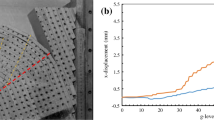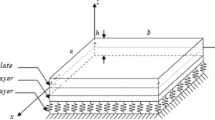Summary
Simple Methods to Analyze Buckling of Rock Slopes
Buckling modes of slope failure are a possibility whenever a throughgoing discontinuity, approximately parallel to the slope, separates a thin slab of rock. Failure by buckling may be initiated by forces external to the slab, by groundwater pressures, by applied forces or by the weight of the slab itself, especially if the slab is curved convex upward.
Simple formulae are developed for three possible cases of buckling: flexural buckling of plane slopes, three hinge buckling of plane slopes and three hinge buckling of curved slopes.
For flexural buckling, Euler's formula is applied after making several simplifying assumptions regarding the geometry of a buckling slab. Three hinge buckling may occur if a slab is cut by cross-joints perpendicular to the slope. Stability of each of the two blocks is determined using equations of force and moment equilibrium, resulting in a series of equations describing the interblock forces required for stability.
The applicability of the three hinge model was tested by applying the equations to a documented failure on an excavated slope. The method gave reasonable results.
Zusammenfassung
Einfache Methoden zur Berechnung des Versagens einer Felsböschung durch Beulung
Eine Böschung oder ein Hang können ausbeulen, wenn eine durchgehende Kluft parallel zur Oberfläche des Hanges in geringer Tiefe existiert. Die Knickung kann durch Kräfte, die von außen her auf die Felsschicht einwirken, wie zum Beispiel Grundwasserdruck, hervorgerufen werden, aber auch durch andere Krafteinwirkungen oder durch das Gewicht der Schicht selbst, besonders wenn sie nach außen gekrümmt ist.
Einfache Formeln für drei mögliche Fälle werden ausgearbeitet: Biegeknickung einer geraden Böchungsfläche, Dreigelenkknickung einer geraden Böschungsfläche, und Dreigelenkknickung einer gebogenen Böschungsfläche.
Für die Biegeknickung wird die Eulerformel angewandt. Gewisse vereinfachende Voraussetzungen in bezug auf die Geometrie einer ausknickenden Schicht werden angenommen. Die Stabilität der beiden Blöcke, bei denen es zur „Dreigelenkknickung“ kommt, wird mit Hilfe des Kräfte- und Momentengleichgewichtes untersucht. Dies führt zu einer Reihe von Gleichungen, die die für Stabilität notwendigen Kräfte zwischen den Blöcken ergeben.
Die Anwendbarkeit des „Dreigelenkmodells“ wurde am Beispiel eines dokumentierten Böschungsbruches untersucht. Die vorgestellte Methode erbrachte plausible Ergebnisse.
Résumé
Méthodes simples pour analyser le flambage des versants rocheux
La rupture d'un talus par flambement peut se produire lorsqu'une discontinuité, approximativement parallèle à la pente, isole une mince dalle de roc. La rupture par flambement peut être initiée par des forces externes à la dalle, par des pressions d'eau, par des forces appliquées ou par le poids de la dalle elle-même, en particulier si la dalle est convexe vers le haut.
Des formules simples ont été développées pour trois cas possibles de flambement: flambement de talus droits par flexion, flambement à trois pivots de talus droits et flambement à trois pivots de talus courbés.
Pour le flambement par flexion, on utilise la formule d'Euler après avoir posé plusieurs hypothèses simplificatrices quant à la géométrie de la dalle. Le flambement à trois pivots peut se produire si la dalle est coupée par des diaclases transversaux, perpendiculaires à la pente. La stabilité de chacun des deux blocs est déterminée eu utilisant les équations d'équilibre des forces et des moments, ce qui résulte en une série d'équations décrivant les forces interblocs requises pour la stabilité.
L'applicabilité du modèle à trois pivots a été vérifiée en appliquant lesé quations à un cas documenté de rupture d'une paroi d'une excavation. La méthode a donné des résultats raisonnables.
Similar content being viewed by others
References
Cavers, D. S.: Design Methods for Open Pit Mine Footwalls. Unpublished Master of Engineering Design Study, University of California, Berkeley 1979.
Chajes, A: Principles of Structural Stability Theory, Civil Eng. and Eng. Mech. Series. Englewood Cliffs, New Jersey: Prentice Hall 1974.
Corbyn, J. A.: Stress Distribution in Laminar Rock During Sliding Failure. Int. J. Rock Mech., Min. Sci. and Geomech. Abstr.15 113–119 (1978).
Goodman, R. E.: Methods of Geological Engineering in Discontinuous Rocks. San Francisco: West Publishing 1976.
Hewlett-Packard: Simultaneous Equations in Six Unknowns, Program written by R. E. DeBolt. In: HP67/97 Users' Library Solutions: High Level Math. Corvallis, Oregon 1978.
Hoek, E., Bray, J. W.: Rock Slope Engineering, 2nd ed. London: The Inst. of Mining and Metallurgy 1977.
Johnson, A. M.: Physical Processes in Geology. San Francisco: Freeman, Cooper & Co. 1970.
Kutter, H. K.: Mechanisms of Slope Failure Other than Pure Sliding. Rock Mechanics, International Center for Mechanical Sciences, Courses and Lectures No. 165, L. Müller ed. New York: Springer 1974.
Author information
Authors and Affiliations
Additional information
With 11 Figures
Rights and permissions
About this article
Cite this article
Cavers, D.S. Simple methods to analyze buckling of rock slopes. Rock Mechanics 14, 87–104 (1981). https://doi.org/10.1007/BF01239857
Received:
Issue Date:
DOI: https://doi.org/10.1007/BF01239857




